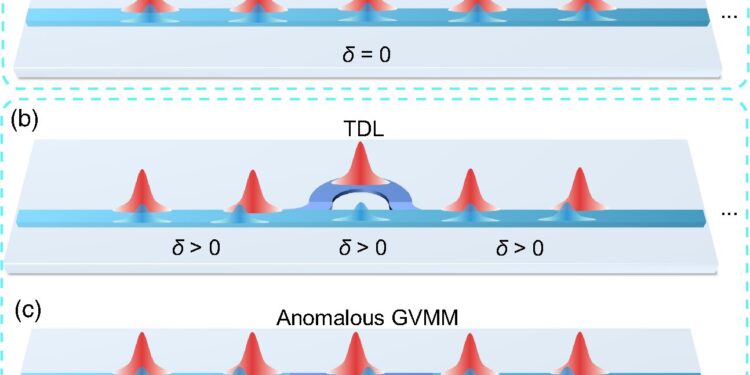Schematics of (a) direct GVM, 23 (b) QGVM realized by TDL, 32 and (c) anomalous GVMM in the phase-matched SHG process, where δ = VgSH−1−VgFW−1. Credit: Advanced Photonics (2024). DOI: 10.1117/1.AP.6.5.056012
Advances in quantum information technology are paving the way for faster and more efficient data transfer. One of the main challenges has been ensuring that qubits, fundamental units of quantum information, can be transferred between different wavelengths without losing their essential properties, such as coherence and entanglement.
As shown in Advanced PhotonicsResearchers from Shanghai Jiao Tong University (SJTU) recently made significant progress in this area by developing a new broadband frequency conversion method, a crucial step for future quantum networks.
The SJTU team focused on a technique using X-cut thin-film lithium niobate (TFLN), a material known for its nonlinear optical properties. They successfully generated a broadband second harmonic – an important process for converting light from one wavelength to another – with a remarkable bandwidth of up to 13 nanometers. This was accomplished through a process called mode hybridization, which allows precise control of frequency conversion in a micro-racetrack resonator.
According to corresponding author Professor Yuping Chen, “an efficient second-order nonlinear process with a widely tunable pump bandwidth is a long-pursued goal, due to the widespread applications in length-division multiplexing networks. wave, nonlinearity of ultrashort pulses, quantum key distribution and generation of broadband single photon sources.
“Thanks to the great advances in manufacturing technology on the TFLN platform, this work will pave the way for chip-scale nonlinear frequency conversion between ultrashort optical pulses and even quantum states.”
This advancement could have broad implications for integrated photonic systems. By enabling on-chip tunable frequency conversion, it opens the door to improved quantum light sources, higher capacity multiplexing, and more efficient multi-channel optical information processing. As researchers continue to explore these technologies, the potential for expanding quantum information networks increases, bringing us closer to realizing their full capabilities in diverse applications.
More information:
Tingge Yuan et al, Chip-scale nonlinear bandwidth enhancement via birefringent mode hybridization, Advanced Photonics (2024). DOI: 10.1117/1.AP.6.5.056012
Quote: Improved wavelength conversion paves the way for more efficient quantum information transfer (October 15, 2024) retrieved October 16, 2024 from
This document is subject to copyright. Except for fair use for private study or research purposes, no part may be reproduced without written permission. The content is provided for informational purposes only.



